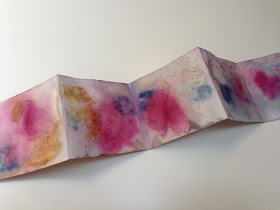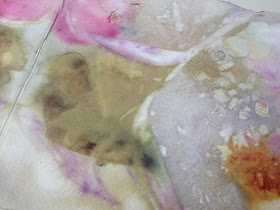A friend of mine and I have been experimenting with dying our own paper using different plants, fruits and vegetables. We were inspired by Laura Ryan's article "Boiled Books" in the Summer 2013 edition of Pages by Cloth Paper Scissors. In the article Laura explains how she uses different plant materials, sandwiched between sheets of watercolor paper and boiled in a bath of water and vinegar to release the magnificent colors and patterns of the organic material.
So...with my scouts looking out for different flowers that were thought to release eye catching colors, I started collecting and preserving flowers in my refrigerator until I had enough variation to start the process. You can freeze the plants too.
Listed below are the plant materials that I used to make the papers pictured but you are not limited to those....there is a whole world of possibilities out there. Experiment!
Ferns - mostly provide pattern
Bushes with leaves - mostly provide pattern
Yellow onion skin - provides mustard and brown colors
Purple onion skin - provides grey and purple color.
Sliced red beets - provides beet red color
marigold flowers - provides orange, mustard and rust colors
Whole blueberries - provides deep blue color
Purple queen plant _ provides delicate purple color and great pattern
Dried crasins - provided only pattern...interesting
Dried Cinnamon - provided a deep rust color
Dried mustard - provided a yellow orange color
Tea and coffee grounds - provided a tea stain look... some speckles.
Sliced strawberries - provided light pink color but the seeds made a great pattern.
(Note: My friend used dried eucalyptus and the dye from the plant added a beautiful turquoise color. Consider dried flowers that you might already have as they can often give off rich colors.)
This is the process:
You will need the following material in addition to the plant materials:
- Sheets of 140 lb watercolor paper (I used Strathmore 300 but my friend used Printmaking paper and the more expensive Arches paper and the colors were much more vivid and the patterns more distinct. The author recommended 100% cotton rag. I discovered that the paper does make a difference. Next time I will use Canson 100 which is 100% cotton.)
- A large stew pot.
- Heavy cardboard, matte board, or plywood cut to the size of your paper but not so large where it will not lay flat in the stew pot. (I used two hot pads that were metal on one side and paper on the other. I found them at a discount store for $1.00 each.)
- Rubber bands, string or clamps to hold the cover tightly to the papers.
- 1 cup white vinegar.
- Tongs, cookie sheet and newspaper.
- Something to weight the paper stack in the water (a brick or heavy object). It needs to be completely submerged.
2. Place the flowers, branches, fruits and vegetables on one side of the paper. Fold over to enclose the vegetation inside the fold.
3. Stack the papers with the vegetation between the folds and place the cardboard or cover material on the top and bottom of the stack. (Squish it down.) Secure with clamps, rubber bands or string.
4. Fill a stew pot with water and 1 cup of white vinegar. Completely submerge the stacked paper in the water and use a brick or heavy object to weight it. Bring the water to a full boil and then reduce to simmer and cook for 1 1/2 hours.
Note: If you want a darker result, you can add coffee, tea, or additional plants to the water.
5. When finished cooking, use tongs to carefully remove the paper from the water and set it on a cookie sheet lined with newspaper. Careful....don't burn yourself or get any of the juice on a light colored formica counter top...it could stain.
6. Allow it to drain overnight.
7. Very carefully, unwrap the papers and remove the large pieces of vegetation. The paper is very fragile when wet and you may need to allow the paper to dry completely. Once dry, use a soft brush to remove the remainder of the vegetation and if necessary, the pages can be ironed to flatten.
 |
| Don't forget scraps to make mini books. |
Hugs,
Ginny





